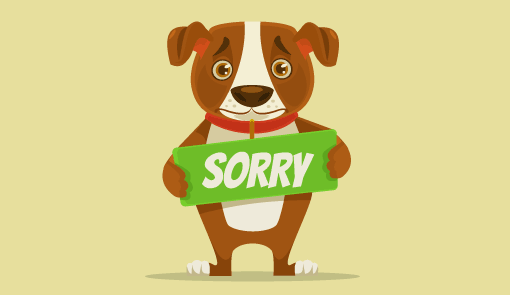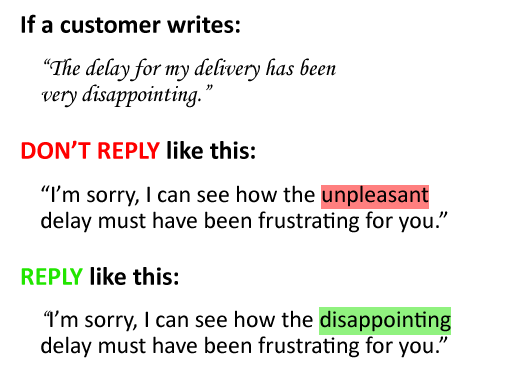We investigate the fundamentals of saying sorry to a customer in a customer service letter.
The Two Key Elements of a Good Customer Apology Letter
While you can create guides, apology letter templates do not work. This is because of these two additions that must be included in any apology letter.
1. Reference the Customer’s Complaint
Don’t just say sorry, acknowledge the customer’s complaint to personalise the apology and allow yourself to show real empathy.
The beginning of any good apology is personalised, saying sorry for the specific thing that went wrong.
Neil Martin, Director at The First Word, says: “The beginning of any good apology is personalised, saying sorry for the specific thing that went wrong.”
“If the customer says something like: ‘The carriage I travelled in was very cold’, say: ‘I’m sorry that the carriage was cold’, not: ‘I’m sorry for the inconvenience’.”
While you cannot template this kind of personalised apology, referencing the customer’s problem takes only a matter of seconds and makes the apology much more authentic.
2. Vary the Strength of the Apology for Different Situations
Customer complaints vary greatly, not just in terms of content but in terms of the emotions involved for the customer. So the degree to which you apologise must vary from one customer to another.
As Neil says: “What’s really sincere in one context can be really insincere in another because it’s either too strong or not strong enough.”
What’s really sincere in one context can be really insincere in another because it’s either too strong or not strong enough.
Insincere apology examples, if you represent the contact centre of a hotel chain, you cannot use the same template apology email for a situation where a customer says that their bathroom light was too dim as you would for a customer who found rats in their room.
In the scenario where rats were found in the customer’s room, you might say: “I’m very sorry you found rats in your room. I can imagine how concerning that would have been for you. We pride ourselves on the hygiene and cleanliness of our hotels and it is not acceptable that this happened during your stay.”
Whereas, for the bathroom light, a simple: “I’m sorry the bathroom light was too dim for your stay with us” is more appropriate. Anything stronger could be interpreted as sarcasm.
The Basic Rules of a Customer Apology Letter
While the two “keys” above are essential, here’s a list of other fundamental rules when writing a sorry note for customer service that you shouldn’t be getting wrong.
Say “Sorry” Not “Apologies”
Often, instead of just a sorry letter, advisors follow templates that rephrase what only needs to be a simple apology.
Neil Martin says: “There is no more sincere word than the word ‘sorry’. But, particularly when it comes to letters, people feel the need to go more formal.”

There is no more sincere word than the word ‘sorry’. But, particularly when it comes to letters, people feel the need to go more formal.
“So, they end up using words like ‘apologise’ or ‘regret’, when they really just want to say sorry, as they would on the phone.”
When someone writes “apologies” or “regrets” it can seem as though they are purposely avoiding the word “sorry” and, while that may not be your intention, that is how many people will interpret it.
Don’t Use the Words “Any” or “May”
There are words that advisors may include in their letter that will completely undermine the apology and imply doubt in the customer’s story. This can frustrate customers, which is the exact opposite of what you want to do – reassure them.
A lot of companies throw a generic apology out there in the hope that it appeases whoever has written in, but people see through that.
Neil says: “Particular bugbears of mine include the words ‘any’ and ‘may’, because you should know – or at least be able to make a safe assumption – that your company has made a mistake. If you don’t, then you shouldn’t be apologising.”
“A lot of companies throw a generic apology out there in the hope that it appeases whoever has written in, but people see through that. So we need to avoid these words and make sure that every apology we write use is personalised.”
Avoid These Phrases
Using Neil’s “bugbear” words and others, here are a few apology phrases to avoid:
- “I’m sorry that we may have…”
- “I’m sorry for any inconvenience caused.”
- “I’m sorry that you felt the need to complain.”
Use These Phrases
More suitable apology phrases, as discussed in our article “16 Apology Statements for Customer Service“, include:
- “I’m sorry, I can see how [INSERT PROBLEM] must have been frustrating for you.”
- “I’m very sorry, I appreciate how difficult it must have been for you to deal with [INSERT PROBLEM].”
- “Thanks for alerting us to [INSERT PROBLEM]. I recognise that this can’t have been an easy thing to deal with and I’m so sorry that we have caused you to feel [INSERT EXPRESSED EMOTION].”
Understand That an Apology and Empathy Are Different Things
Earlier we stated that you shouldn’t apologise if you haven’t made a mistake. However, this doesn’t mean that you shouldn’t show empathy. After all, an apology and empathy are two different things.
As Neil says: “You need to know whether the customer deserves an apology or not. It’s just as bad to apologise for something that you haven’t done wrong as it is to offer an insincere apology when you have done something wrong. This is because it adds up to the same thing – sounding insincere.”
It’s just as bad to apologise for something that you haven’t done wrong as it is to offer an insincere apology when you have done something wrong. This is because it adds up to the same thing – sounding insincere.
“While sometimes you might have to give the customer the benefit of the doubt, you need to make a decision either way. And if you decide that an apology isn’t necessary, show empathy for how the customer feels.”
“There is a big difference in saying ‘this is our fault’ as opposed to ‘I understand how you feel’. Even if you don’t say sorry, you can show that you have understood the customer’s problem.”
Just remember that if a customer has had a problem and they’ve taken the time to talk to you about it, empathy always has a place, but the apologies only have a place when the company’s done something wrong.
Some examples of empathy statements that don’t ‘say sorry’ to the customer include:
- “I can see how frustrating this must be for you…”
- “Thank you very much for alerting us to this…”
- “I appreciate you bringing this to our attention…”
For more examples of similar phrases, visit: 18 Empathy Statements That Help Improve Customer-Agent Rapport
Reflect Back Where Appropriate
Reflecting back the customer’s words will help to demonstrate that you have understood their problem and helps to further personalise the apology.
Neil says: “If we describe an event in two different ways, even if the same thing happens, we won’t really feel as though the other person is on our wavelength. So it’s best to describe it using their language.”

However, Neil also warns: “Just be careful that it is appropriate for you to use their exact language and that you actually agree with the customer, because by reflecting back someone’s words, you are, in a way, complicit with them.”
“So, if someone says that ‘this is absolutely abhorrent’ and it wasn’t, don’t reflect back their words if you don’t really agree with them.”
However, when used correctly, this technique can be great to show the customer that you understand their problem, which is important in reassuring the customer after an apology.
Don’t Be Too Defensive – Even When the Customer’s Wrong
Culturally, organisations can be very defensive, with many advisors feeling as though their job is to defend the reputation of their company, which can lead to them adopting the wrong approach when writing.
When it comes to a customer service letter, there is a misconception that the letter is almost some sort of legal document, when it’s not.
Neil adds: “A lot of people in complaint handling interpret their role to mean that we can never say the words ‘I’m sorry’, thinking that saying so is a sign of weakness.”
“When it comes to a customer service letter, there is a misconception that the letter is almost some sort of legal document, when it’s not. Just remember that you’re still in the realms of good will and not legality.”
This brings up another point of not being scared to be informal, particularly if the customer isn’t formal themselves. If you use less formal techniques, such as writing “I’m” instead of “I am”, you’ll appear more genuine.
For more advice on offering apologies in customer service, from expert Liz Doig, read our article: “Sorry for the Inconvenience” – How to Offer a Genuine Apology
How to Structure an Apology Letter
Now we know the keys in terms of language and approach to an apology letter, what about the order in which we present information?
Start With a Thank You and Then Apologise Straight After
While a letter may seem like a more formal channel of communication, the structure of an apology shouldn’t differ too much from an email, in that the apology statement should come as early as possible.

Neil Martin
As Neil Martin says: “When somebody is expecting an apology, they want it straight away. So, while you might want to start the letter with a ‘thanks for getting in touch’, as a convention, the apology should follow straight after.”
“The exact same words mean a lot less at the bottom of the page. Often an advisor will write something from a chronological point of view, explaining what they’ve done before ending on the ‘… therefore I’m sorry’.”
However, when reading a long block of text, it will be common for the customer to just scan the page. Therefore, if you bury the apology, not only will it seem as though you’re “hiding” it, but there’s a chance that the reader will never even see it.
Follow That Up With Your Solution
The basic principle of writing to customers is to order the content in terms of importance to the customer. Therefore, straight after the “thank you” and apology should come the solution.
Neil adds: “People want to know what you’re going to do to resolve their query. So, whatever the solution may be, put that right after your personal apology.”
“Some people will be interested in why you think that solution is appropriate, but some people won’t. So, while you should include details of your investigation or your explanation for your decision, don’t put that first.”
With this in mind, the structure of your apology letter should follow the format below:
- First say thank you to the customer for getting in touch
- Apologise for what’s gone wrong or show empathy if an apology is not required
- Share what you’re doing to put it right
- Tell the customer why you’re taking these actions
- Include a call to action if the customer needs to do anything
- Offer further reassurance and other contact details.
A Customer Apology Letter Example
Now we know how to structure an apology letter to a customer and the key do’s and don’ts, let’s take a look at an example that includes all of these best practices.
In this example, we are offering a response to a complaint where a customer has complained about having to stand up on a train.
The Customer’s Compliant
Dear Sir/Madam,
I went from Swindon to Bath last Saturday to watch the rugby. It was packed the moment I got on and I had to stand all the way. I then had the same on the way back – not great! It put a real downer on the day.
You know that rugby match days are going to be busy so why don’t you put on more trains and carriages? I really don’t fancy the prospect of standing again.
Yours sincerely,
Steve
The Apology Letter
Dear Steve,
Thanks for getting in touch about your return journey from Swindon to Bath last Saturday.
I’m sorry to hear you had to stand on the way to and from Bath when you travelled with us. I can see how this would put a downer on your day.
We do put on extra trains and carriages during match days. At certain times, particularly the 11.13 service and the 17.52 service you were on, the trains get very busy as these are such popular times to travel.
The best way to make sure you get a seat is to book in advance at trains.com. You’ll also get the cheapest fare that way.
Or if you prefer, give us a call on 01234 567890 and one of our team will be happy to book them for you.
Please let us know if there is anything else that you would like to discuss, we always appreciate feedback from our customers.
All the best,
Sarah
However, there are also a few other additions to this letter which improve its quality. These include:
It adds in personal information – As well as reflecting back on what the customer said, this example goes one step further, identifying what times the customer travelled. This signals to the customer that the advisor has done their research.
It uses first-person pronouns – The advisor takes ownership of the customer’s problem, saying “I’m sorry” and “I can see”, instead of using the more corporate “we”, which lacks authenticity.
It sticks to one idea per sentence – In this letter, long chunks of information are broken up into short sentences, to make all the information easily digestible, with each sentence presenting one idea at a time.
It follows the customer’s lead – Instead of starting with “Hi” the advisor uses “Dear”, just like the customer had done, so the advisor is leading with language that they know the customer is comfortable with.
It directs the customer to a more efficient channel – After presenting all the key bits of information, the advisor presents internet self-service and offers a phone number, which helps to influence the customer’s choice of channel.
In Summary
When writing an apology letter for customer service, you must say “sorry”, reference the customer’s issue and show empathy, while it’s also important to vary the strength of the apology so it fits the seriousness of the issue.
Other best practices include using the customer’s language where appropriate, avoiding words like “any” or “may” and sticking to one idea per apology sentence.
Finally, in terms of structuring the apology letter, start by thanking the customer for getting in touch, then add your apology statement and empathy, before sharing the proposed solution.
For more on writing letters to customers, read our articles:
- How to Write a Good Customer Service Letter – With Examples
- How to Write a Thank-You Letter to a Customer – With Examples
- Dear Valued Customer – How NOT to Write a Customer Service Letter
Author: Robyn Coppell
Reviewed by: Megan Jones
Published On: 27th Mar 2019 - Last modified: 27th Aug 2025
Read more about - Customer Service Strategy, Apologies, Editor's Picks, Handling Customers, Language, Rapport, Service Strategy
















